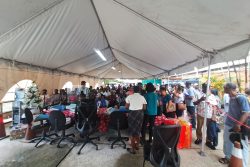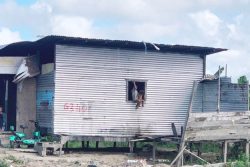(This is Part Three of a series of five reviewing the reports of the Guyana Forestry Commission for 2005-12 which were tabled in Parliament on November 7th, 2013)
By Janette Bulkan and John Palmer
In the second article in this series, we offered comments on the summary accounts of the Guyana Forestry Commission for the eight years 2005-2012 and the associated statements by the Auditor General often several years later. In this third article, we offer comments on the general principles for annual reports (ARs) from government agencies and note peculiarities common in the eight reports from the Guyana Forestry Commission (GFC).
B. General principles of annual reports –
B1. Standard structure and format for annual reports – it is conventional for annual reports to follow a standard format from year to year, to facilitate study of trends. The GFC has not consistently followed this convention as regards either sequence of structure or contents.
B2. GFC annual reports apparently written long after the events – it is clear that at least some parts of these reports have been written long after the nominal year of report. For example, the reports for years 2005 and 2006 refer to the Low Carbon Development Strategy although the LCDS was not first issued until mid-2009.
B3. GFC Board of Directors not compliant – it is for the GFC Board of Directors to present ARs to the appropriate Minister and for the Minister to present the ARs to the National Assembly. Only for the draft report for 2012 is there inclusion of a foreword by the chair of the GFC Board and even that is not explicitly for or on behalf of the Board. Perhaps this is because the membership of the Board does not comply fully with the qualifications listed in the GFC Act (Section 7 (3))? Lack of compliance with legal procedure suggests a culture of disrespect for the National Assembly’s role in oversight of government agencies. The ARs are notably silent on what the GFC Board itself achieves each year.
B4. Failures to address implementation of national policies and strategies – this failure to present the most basic characteristics conventional in reports of government agencies – that is, the reporting on performance against national policies and strategies approved by the National Assembly – is a serious deficiency in the direction and management of the GFC, and makes it unnecessarily difficult to trace trends in performance. The Sectoral Committee on Natural Resources should demand that the GFC (and Environmental Protection Agency, Guyana Geology and Mines Commission, and Guyana Lands & Surveys Commission) report on their performance against policies.
B5. Failures to report on performance of the forest sector – annual reports should tell what actually happened in relation to what was planned, and to explain the differences. Apart from congratulating itself in most years on achieving more than 90 per cent of its plans, the GFC makes almost no attempt to show its plans or to comment on what actually happened in relation to those plans. The ARs mostly concentrate on process, not on performance, yet at the same time fail to situate the activities within the national forest policy process – as noted below. Explanations are almost conspicuous by their absence. There has been no attempt in these eight reports to compare progress against the national forest policy (1997) and national forest plan (2001) or, for the AR 2012, against the revisions of policy and plan made in 2011; there is a brief reference on page 13 of AR 2007. In spite of all the many references to training courses, almost nothing is reported on how these capacity buildings have affected the performance of the GFC staff.
B6. Failures to explain effects of drivers of change – an important function of ARs is to explain (or suggest) how external drivers affect sector performance. For example, the transfer of areas of peri-urban land from government control to private land developers for housing estates appears to have affected the market for domestic sawnwood, with unnecessary demand for prime commercial timbers to be used in mundane structures which could have been perfectly well served by lesser-known species with equivalent or adequate technical performance. No such analysis is presented. So far, the GFC does not appear to have translated laboratory data on timber properties into leaflets and guides suitable for semi-literate builders and contractors. It is not reported that the GFC has communicated laboratory data to the Guyana National Bureau of Standards, for updating the relevant national standards for construction/house-building.
B7. Implications of large numbers of external projects, including training – the GFC operates a relatively large number of externally-funded projects. These include several capacity-building/training projects during 2005-2012. Certainly it is important to say how many GFC staff went for what kind of training, where and when. But it is also important to indicate what lasting benefits have been obtained from this training, how GFC procedures and practices have changed as a result of the training, how national policies and strategies are better addressed by better-trained staff, and how overall and specific performances have improved. The audited accounts make no explicit mention of the sub-accounts for the numerous projects; who has been undertaking the external audits of these projects, and with what results?
B8. Consequences of continued high turnover of staff – while these external projects bring in useful income as overheads and administration fees (not explained or differentiated in the annual accounts), the projects also impose a considerable load on GFC HQ in reporting requirements. The high turnover of staff is shown in the ARs but the reasons are explained only in relation to junior staff, no counter-measures are suggested, and the effects on performance are not indicated.
B9. Focus on technical projects – there does not seem to be a GFC analysis to show that technical issues are critical in the forest sector, so why are almost all the projects of a technical nature? Why is there not more attention to institutional and business development, enterprise financing, and to the REDD+ Governance Development Plan published in June 2011 under the Norway-Guyana MoU of November 2009? – the RGDP is not mentioned in AR 2012. More generally, why are the numerous projects listed by the GFC and by Departments within the GFC not situated within the contexts of the national forest policy and national forest plan? Failure to provide context suggests that projects are ad hoc in nature and are not responding to any set of national priorities approved by the National Assembly. And in passing it should be noted that the 2011 revision of the national forest policy has not been presented for approval by the National Assembly.
B10. Nonsensical additions – most of the ARs contain summations of annual production as logs + roundwood + sawnwood + plywood + splitwood. This makes no sense. The international convention is to convert all processed wood to roundwood equivalents, which can then be summed reasonably to show total forest production on the same basis. For example, the volume of sawnwood should be divided by 0.4, the conversion ratio adopted by the GFC to indicate the average efficiency of sawmilling, to arrive at the volume of logs from which the primary (chainsawn) sawnwood was cut. Clearly, instead of adding plywood to the production total, the GFC should instead be noting the estimated volume of logs from which Barama produces plywood (divide ply production by 0.46, Barama’s conversion ratio stated in the Samling Global Initial Public Offering on the Hong Kong Stock Exchange in 2007), in order to avoid double counting, because Barama’s logs for ply production were already included in overall log production. This is the correct way of estimating the volume of logs used by fixed (urban-based) sawmills to produce sawnwood (lumber) and hence the size of the domestic market for sawnwood (mill-sawn and chain-sawn), after subtracting volumes of sawnwood exported.
B11. National Integrated Land use Planning – there is no mention in these ARs about lack of progress in national integrated land use planning (ILUP). Such planning had been demonstrated in a pilot project in Region 10 in 1997. ILUP has been national policy since the drafts of the National Development Strategy in 1997. Concern about the increasing wastage of commercial timber in artisanal (small- and medium-scale) gold mining through failure to coordinate licensing of mining by GGMC and of logging by GFC was one stimulus for the Special Land Use Committee appointed by former President Jagdeo in 2009, with no apparent changes being seen in national policies or practices. Revival of ILUP is indicated in the strategic plan for the Ministry of Natural Resources and the Environment in January-April 2013, but no progress has been announced in the National Assembly.
In the fourth article in this series, we will address some specific topics raised in these eight GFC annual reports. (Editor’s note: The fourth article will appear in the January 30th edition of Stabroek News.)





